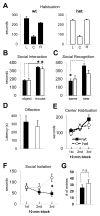Reduced expression of the NMDA receptor-interacting protein SynGAP causes behavioral abnormalities that model symptoms of Schizophrenia
- PMID: 19145222
- PMCID: PMC3690772
- DOI: 10.1038/npp.2008.223
Reduced expression of the NMDA receptor-interacting protein SynGAP causes behavioral abnormalities that model symptoms of Schizophrenia
Abstract
Abnormal function of NMDA receptors is believed to be a contributing factor to the pathophysiology of schizophrenia. NMDAR subunits and postsynaptic-interacting proteins of these channels are abnormally expressed in some patients with this illness. In mice, reduced NMDAR expression leads to behaviors analogous to symptoms of schizophrenia, but reports of animals with mutations in core postsynaptic density proteins having similar a phenotype have yet to be reported. Here we show that reduced expression of the neuronal RasGAP and NMDAR-associated protein, SynGAP, results in abnormal behaviors strikingly similar to that reported in mice with reduced NMDAR function. SynGAP mutant mice exhibited nonhabituating and persistent hyperactivity that was ameliorated by the antipsychotic clozapine. An NMDAR antagonist, MK-801, induced hyperactivity in normal mice but SynGAP mutants were less responsive, suggesting that NMDAR hypofunction contributes to this behavioral abnormality. SynGAP mutants exhibited enhanced startle reactivity and impaired sensory-motor gating. These mice also displayed a complete lack of social memory and a propensity toward social isolation. Finally, SynGAP mutants had deficits in cued fear conditioning and working memory, indicating abnormal function of circuits that control emotion and choice. Our results demonstrate that SynGAP mutant mice have gross neurological deficits similar to other mouse models of schizophrenia. Because SynGAP interacts with NMDARs, and the signaling activity of this protein is regulated by these channels, our data in dicate that SynGAP lies downstream of NMDARs and is a required intermediate for normal neural circuit function and behavior. Taken together, these data support the idea that schizophrenia may arise from abnormal signaling pathways that are mediated by NMDA receptors.
Conflict of interest statement
The author(s) declare that, except for income received from my primary employer, no financial support or compensation has been received from any individual or corporate entity over the past three years for research or professional service and there are no personal financial holdings that could be perceived as constituting a potential conflict of interest.
Figures






Similar articles
-
Clozapine reverses schizophrenia-related behaviours in the metabotropic glutamate receptor 5 knockout mouse: association with N-methyl-D-aspartic acid receptor up-regulation.Int J Neuropsychopharmacol. 2009 Feb;12(1):45-60. doi: 10.1017/S1461145708009085. Epub 2008 Jul 2. Int J Neuropsychopharmacol. 2009. PMID: 18593507
-
Therapeutic potential and underlying mechanism of sarcosine (N-methylglycine) in N-methyl-D-aspartate (NMDA) receptor hypofunction models of schizophrenia.J Psychopharmacol. 2019 Oct;33(10):1288-1302. doi: 10.1177/0269881119856558. Epub 2019 Jul 11. J Psychopharmacol. 2019. PMID: 31294644
-
Pathogenic disruption of DISC1-serine racemase binding elicits schizophrenia-like behavior via D-serine depletion.Mol Psychiatry. 2013 May;18(5):557-67. doi: 10.1038/mp.2012.97. Epub 2012 Jul 17. Mol Psychiatry. 2013. PMID: 22801410 Free PMC article.
-
Glutamate NMDA Receptor Antagonists with Relevance to Schizophrenia: A Review of Zebrafish Behavioral Studies.Curr Neuropharmacol. 2022 Mar 4;20(3):494-509. doi: 10.2174/1570159X19666210215121428. Curr Neuropharmacol. 2022. PMID: 33588731 Free PMC article. Review.
-
Genetic influence on the working memory circuitry: behavior, structure, function and extensions to illness.Behav Brain Res. 2011 Dec 1;225(2):610-22. doi: 10.1016/j.bbr.2011.08.016. Epub 2011 Aug 22. Behav Brain Res. 2011. PMID: 21878355 Free PMC article. Review.
Cited by
-
Mutant mouse models: genotype-phenotype relationships to negative symptoms in schizophrenia.Schizophr Bull. 2010 Mar;36(2):271-88. doi: 10.1093/schbul/sbp125. Epub 2009 Nov 24. Schizophr Bull. 2010. PMID: 19934211 Free PMC article.
-
Species-conserved SYNGAP1 phenotypes associated with neurodevelopmental disorders.Mol Cell Neurosci. 2018 Sep;91:140-150. doi: 10.1016/j.mcn.2018.03.008. Epub 2018 Mar 24. Mol Cell Neurosci. 2018. PMID: 29580901 Free PMC article. Review.
-
Mouse models of SYNGAP1-related intellectual disability.Proc Natl Acad Sci U S A. 2023 Sep 12;120(37):e2308891120. doi: 10.1073/pnas.2308891120. Epub 2023 Sep 5. Proc Natl Acad Sci U S A. 2023. PMID: 37669379 Free PMC article.
-
Postmortem brain: an underutilized substrate for studying severe mental illness.Neuropsychopharmacology. 2014 Jan;39(1):65-87. doi: 10.1038/npp.2013.239. Epub 2013 Oct 4. Neuropsychopharmacology. 2014. PMID: 24091486 Free PMC article. Review.
-
Genetic models of sensorimotor gating: relevance to neuropsychiatric disorders.Curr Top Behav Neurosci. 2012;12:251-318. doi: 10.1007/7854_2011_195. Curr Top Behav Neurosci. 2012. PMID: 22367921 Free PMC article. Review.
References
-
- Albin RL, Young AB, Penney JB. The functional anatomy of basal ganglia disorders. Trends Neurosci. 1989;12(10):366–375. - PubMed
-
- American Psychiatric Association., American Psychiatric Association. Task Force on DSM-IV. Diagnostic and statistical manual of mental disorders: DSM-IV. 4. American Psychiatric Association; Washington, DC: 1994. p. xxvii.p. 886.
-
- Astrup C. Schizophrenia; conditional reflex studies. Thomas; Springfield, Ill: 1962. p. xx.p. 345.
-
- Ax AF. Individual differences in autonomic learning: a quarter century of reflection. Int J Psychophysiol. 1990;10(1):1–9. - PubMed
Publication types
MeSH terms
Substances
Grants and funding
LinkOut - more resources
Full Text Sources
Other Literature Sources
Medical
Molecular Biology Databases

